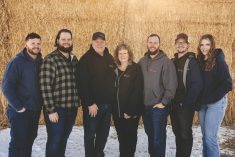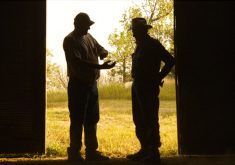Volunteers are the heart of a community. Despite their isolation and sparse populations — or maybe because of it — farm communities in particular have been held up for generations as models of neighbourliness, with families supporting each other in times of need.
Now, neighbourliness may not be enough. Something more structured is needed, with farmers and farm families taking a more active role as volunters.
With declining and aging populations in many rural areas, the quality of life in our communities is under threat.
Karen Kirkwood-Whyte is the CEO of United Way in Chatham-Kent, a single-tier mostly rural municipality in Ontario’s southwest. With 35 years’ experience in the non-profit sector, Kirkwood-Whyte has witnessed these demographic changes and their effects firsthand.
Read Also

Employment Agreements Can Help Protect Your Farm
Entering into employment agreements with each of your farm employees should be at the top of every farm’s “to do” list, but caution must be exercised.
In the past two decades, the population of Chatham-Kent, which currently sits at just over 102,000, has declined by more than six per cent due largely to the loss of local manufacturing jobs.
“Agriculture is where it’s at now,” observes Kirkwood-Whyte.
Meanwhile, a number of initiatives have been put in place locally to help maintain a strong and healthy community, and Kirkwood-Whyte has been invited to speak about the direction they are taking, such as at the Ontario Nonprofit Network Conference in Toronto.
Recently, I had the opportunity to talk to Kirkwood-Whyte about the challenges and successes in Chatham-Kent.
Question: What are the challenges facing volunteerism in rural communities?
Kirkwood-Whyte: There are significant differences between urban life and rural life. Vast geographic areas and transportation challenges can create feelings of loneliness and isolation. Declining population, declining memberships in local service clubs, and youth out-migration are sad realities.
While there are real challenges including poverty, mental health issues and the emerging opioid crisis, I prefer to focus on the strengths. Communities too often focus on what’s missing, the half-empty glass. This is the philosophy behind Asset-Based Community Development (ABCD), a framework conceived by John Mc-Knight of Northwestern University in Chicago.
According to management guru Peter Drucker (best known as the father of modern business management but who went on to work in the non-profit sector after his retirement), a healthy society requires three vital sectors — a public sector of effective government, a private sector of effective business, and a social or non-profit sector of effective community organizations.
As the lines continue to blur between the business, government and voluntary sectors of the community, the third leg of the stool in Drucker’s “tri-sector integration” concept is getting wobbly.
I believe citizens are at the heart of functioning democracies. There can be serious consequences when government employees begin to do things for citizens that they can do themselves with the support of community volunteers and those who work in the public benefit non-profit sector. The potential loss of community ownership is a real concern.
The social fabric of everyday life is not something we want to see eroded. We have much more work to do in the area of civic engagement.
I agree with Cormac Russell who spoke recently at the Bank of I.D.E.A.S. in Western Australia. Russell says we need to reboot democracy and “reverse the trend of the last 50 years which has turned active citizens into satisfied or dissatisfied customers/clients/tax payers, and to address the historically low trust people have in government and other institutions.”
Question: What initiatives has Chatham-Kent taken to improve collaboration among these key sectors?
Kirkwood-Whyte: There are five capacities that build community. These are an abundance of social capital (this is the glue that holds everything together), strong connections with the outside world (bringing knowledge gained elsewhere back home), a willingness and capacity to welcome and integrate newcomers, an ability to adapt and innovate, and a capacity to collaborate.
The last one is actually the toughest. There is a need to better collaborate (both inter-agency and inter-sector) to break down silos and to identify and eliminate duplication. With funding from the Ontario Trillium Foundation, Chatham-Kent has created a non-profit network to encourage collaboration between public benefit organizations.
A little more than a decade after the City of Chatham amalgamated with the surrounding County of Kent (in 1998), our mayor established in 2012 a Community Leaders Cabinet with representation from the business, government and non-profit sectors. This group meets three times per year and works together to identify strategies that will achieve a better quality of life in Chatham-Kent.
Also, our United Way established a community hub in 2006 to house several local charities and community service organizations so they could share resources such as a board room, photocopier, training space, and central reception services.
We’re very proud of this because there’s no need to have six of everything. It was a challenge for the United Way board to commit to a 10,000-square foot space when that was much more than was needed, but our shared space has worked very well.
Question: Are you doing any special initiatives to help newcomers integrate into the community?
Kirkwood-Whyte: Newcomers are arriving and they have much to offer. Chatham-Kent was the first community in Canada to be recognized as a Welcoming Community. Several Syrian families are making Chatham-Kent their home and, in particular, our Local Immigration Partnership (LIP) and Adult Language and Learning organization have been actively involved in working with newcomers to help them get settled.
With a municipal grant, our LIP and Chatham-Kent Nonprofit Network (CKNN) have hosted two Diverse City Parties, each with more than 250 people in attendance, who enjoyed sampling foods and watching cultural dancers perform.
This was an idea Chatham-Kent borrowed from Vu Le, a writer, public speaker, and executive director of a Seattle, Washington non-profit organization. The Chatham-Kent Non-profit Network invited Vu Le to present his ideas on strengthening the voluntary sector at a United Way annual meeting in 2015.
Question: Do you think people are aware of all that the voluntary sector contributes?
Kirkwood-Whyte: There needs to be better recognition of the work undertaken by the non-profit sector.
We need to showcase our relevance in the building of stronger, safer and more caring communities. Chatham-Kent, with its population of just over 102,000, has 550 non-profits and charities (including places of worship). This sector employs more than 1,000 full-time and 1,000 part-time employees, contributes more than $135 million in economic value and boasts over 30,000 volunteers.
Question: The face of volunteerism is changing. Do you have any ideas for how to engage new volunteers?
Kirkwood-Whyte: There are challenges of demography and more and more great causes competing for attention. Every single citizen has a gift to share. The goal is to identify those gifts — whether it’s time, talent or treasure — and then simply ask individuals to share them.
According to data from Stats Canada cited in Tracy Birtch’s report on rural volunteerism for the Rural Ontario Institute, almost half of people currently not volunteering said it was because no one had asked them to do so.
There’s a tremendous amount of potential in retirees and we’re trying to attract the youth back for the great quality of life we enjoy here in Chatham-Kent. Volunteers tend to be more focused on events and short-term tasks rather than long-term commitments.
Question: What impact is technology having on the non-profit sector?
Kirkwood-Whyte: While technology is creating opportunities for non-profits and charities, it’s a challenge to keep up and develop appropriate tools because of limited financial resources.
We’ve seen tremendous changes in technology since I started at United Way 35 years ago. When I began my career, I worked with a hand-me-down adding machine without a tape, a manual typewriter, a Gestetner and a box with recipe cards to record charitable donations.
For our United Way, which fundraises on behalf of more than 30 small charities, it’s becoming more difficult to compete with third-party, private sector fundraisers who have a significantly different bottom line.
It’s also been a challenge to retain some young talent who can earn more money in the government or private sector while working fewer hours. However, some young people really want to make a difference in the lives of others and are willing to take less money in return for a feel-good job. We’re putting an emphasis on that when attracting new employees to our organization.
Resources
Nonprofit AF
Seattle, Washington non-profit executive director and blogger, Vu Le writes about topics of interest to the non-profit sector with humour.
Bank of I.D.E.A.S.
Bank of I.D.E.A.S (Initiatives for the Development of Enterprising Action and Strategies)
Rural Ontario Insitute – Foresight Papers
Rural Ontario Institute Foresight Paper, Rural Volunteerism: How well is the Heart of Community Doing?
















